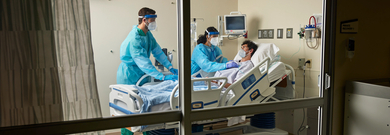5m Read
March 27, 2025
COMMUNITY AND GLOBAL HEALTH
Expert Perspective
The State of TB in the U.S., an Overlooked Opportunity for Better Results
We know tuberculosis (TB) is an urgent public health concern, especially globally, likely resurging as the world’s deadliest infectious disease. An often-overlooked piece of the story, however, is the impact of TB in the U.S. While its prevalence is lower than in other parts of the world, it is still dangerous to communities and costly to hospital systems at home. So, what can we learn from our testing abroad? This is one case where the U.S. has fallen behind in testing protocols and every healthcare facility could benefit from reviewing their approach.
Back when I was Medical Director of the Clinical Microbiology Laboratory at the University of Texas Medical Branch (2008-18), we could initially only test for TB cases Monday through Friday because the testing lab was closed on the weekends. Of course, patients would still come in on the weekends, presenting with potential TB symptoms. We would get complaints from our doctors like, “Why can’t I test for TB on the weekend? We can’t get results fast enough to make decisions on managing patients.”
Not only complaints, but precautionary protocols meant those patients would have to enter expensive isolation rooms until their results came back negative. Because the incidence of TB was relatively low in the U.S., you can imagine, many of those patients were isolated for unnecessarily long periods – at high costs to the health systems and personal costs to the patients – only to learn weeks or days4 later that they were negative.
Whenever a patient presents with potential TB symptoms like a cough and bloody sputum, they are considered a potential case. The traditional testing methods (smear microscopy/culture) took days or weeks for a result. Not only that, but due to the low sensitivity, they required three sputum smear microscopy tests to confirm a negative result. And because each result had to be read by a highly trained technician, the hospital might even send out the samples to a reference lab thousands of miles away.
When the doctors complained that they needed a better way, we considered two options. We could either hire more highly-trained technicians to work during the weekend shift, or we could bring in an automated PCR testing system like Cepheid GeneXpert® to test around the clock – nights and weekends. The math was simple: we calculated that the savings from the system would rapidly pay off. The highly sensitive PCR test could confirm negative cases with one sample.
A patient could walk in, presenting with TB (cough bloody sputum, night sweats, fever, weight loss) and within hours be confirmed negative. No waiting for smear microscopy results from multiple sputum samples, less time in expensive isolation rooms, and potentially less stress to the patient or the system. This was an easy yes. High confidence from one sample meant a definitive answer days earlier than with traditional testing methods.
When we brought TB testing in-house to our health system, we also consolidated our other laboratory molecular testing onto a single system, the GeneXpert Infinity, which could do our other testing as well including influenza, C. diff, Group B strep, and MRSA, for scale and volume. The doctors loved the faster, actionable turnaround. Patients in our opinion were more satisfied. We could be confident we were ruling out cases, avoiding unnecessary isolation cost and time, and knowing right away what was causing our patients’ sickness.
The hospital laboratory administrator, CFO, and I were later approached to continue to cut costs. Someone brought up PCR as an expense, but now that staff was accustomed to the simple and efficient workflow, they said “No way, you can’t take away our Cepheid GeneXpert.” And luckily, the financial numbers clearly supported their clinical wishes.
Today, there are still many healthcare systems that have not taken advantage of these fast, sensitive TB tests and are still relying on traditional methods. With the ongoing prevalence of TB in the U.S. from global travel and as strains have become more resistant to antibiotic treatment and more dangerous to the community at large, the need for quick, accurate, and easy answers is even greater. In certain parts of the world, TB prevalence is extremely high and the need to test onsite can enable quick and accurate diagnosis for same-day treatment. Patients in the U.S. deserve the same fast, accurate, high-quality care.
TB in the U.S. By the Numbers: A Growing Cause for Concern
While the burden of TB disease exists outside the U.S., we are seeing an increase in TB cases in certain places in the U.S. TB cases had been steadily declining in the U.S. prior to the COVID-19 pandemic. However, TB case counts and incidence rates increased each year from 2021 to 2023, indicating lost ground in TB management. It is estimated that there are around 13 million cases of latent TB in the U.S. and only about 10% of those people have completed treatment leaving a reservoir of more than 12 million people who are at risk of progression to active disease and potential transmission.1
In 2021, in Washington state, there was a large increase in active cases as well as evidence of community transmission to levels that had not been seen in two decades with 199 cases of active TB, a 22% increase from 2020. Tao Sheng Kwan-Gett, MD, Washington Department of Health's Chief Science Officer said, “It’s been 20 years since we saw a cluster of TB cases like this. Increased access to TB testing and treatment in the community is going to be key to getting TB under control.” As of January 31, 2025, there is an outbreak of TB in Kansas with 67 cases of active TB, making it one of the largest in the U.S. in the past 30-40 years.
What the Research Tells Us about Clinical and Economic Benefits of In-house TB Testing
For hospitalized patients with presumptive pulmonary TB in a low burden setting, nucleic acid amplification tests (NAATs) can reduce airborne infection isolation (AII) and is comparably sensitive, more specific, and more cost-effective than smear microscopy. A cost-effectiveness analysis of the study results demonstrated that an Xpert test on 1 unconcentrated sputum sample is the most cost-effective strategy and on average would save 51.5 patient-hours in AII and up to $11,466 relative to microscopy without a compromise in sensitivity.2
In hospitalized patients, Xpert TB testing led to a reduction in median time to isolation discontinuation (2.9 vs 2.5 days) and hospital discharge (6.0 vs 4.9 days), on average saving $13,347 per isolated TB-negative patient. A sputum molecular testing algorithm to guide discontinuation of respiratory isolation for patients undergoing evaluation for active TB was safe, feasible, widely and sustainably adopted, and provided substantial clinical and economic benefits. Molecular testing may facilitate more efficient, patient-centered evaluation for possible TB in U.S. hospitals.3
Closing Remarks on Bringing the Global Impact of Molecular TB Testing, Home
From my tenure as a Professor, Department of Pathology, and Medical Director, Clinical Microbiology Laboratory at the University of Texas Medical Branch, I’ve shared insights on how to address the need for quick and accurate TB testing in the U.S., just as we've implemented in many high-burden regions around the world. I had the honor of serving as a member of the Board of Scientific Counselors to the U.S. Centers for Disease Control and Prevention (CDC) from 2015 to 2022. Now with Cepheid, a global leader in molecular diagnostics, I hope to inspire and mentor the next generation of scientific leaders toward positive change, and I’m driven by the opportunity to make an impact on people’s lives. I've shared one way I believe we can make that a reality.
References:
- Mancuso J et al. Self-reported Engagement in Care among U.S. Residents with Latent Tuberculosis Infection: 2011-2012. Ann Am Thorac Soc. 2021 Oct;18(10):1669-1676
- Cowan et al. Clinical Impact and Cost-effectiveness of Xpert MTB/RIF Testing in Hospitalized Patients With Presumptive Pulmonary Tuberculosis in the United States
- Chaisson et al. Association of Rapid Molecular Testing with Duration of Respiratory Isolation for Patients with Possible Tuberculosis in a US Hospital. JAMA Intern Med. 2018;178(10):1380–1388
- DM Warshauer et al. Mycobacterium tuberculosis complex. In, Manual of Clinical Microbiology, 13th Ed. 2019. ASM Press.
Read Next
MORE








